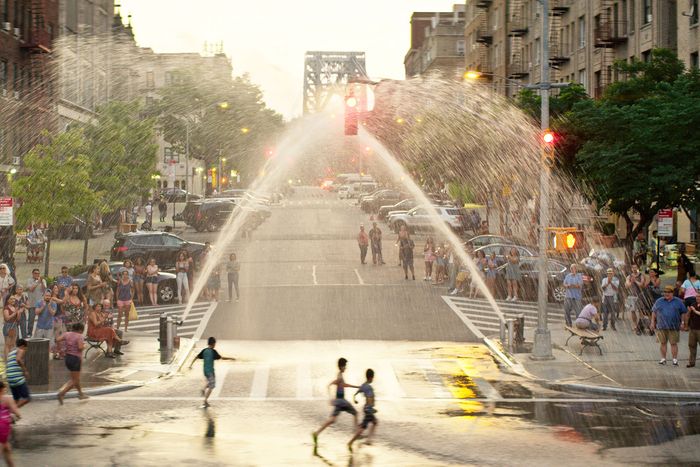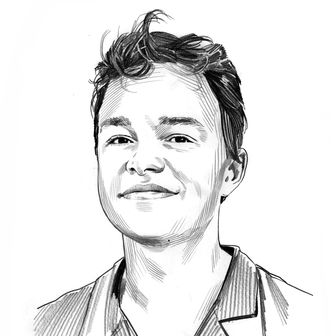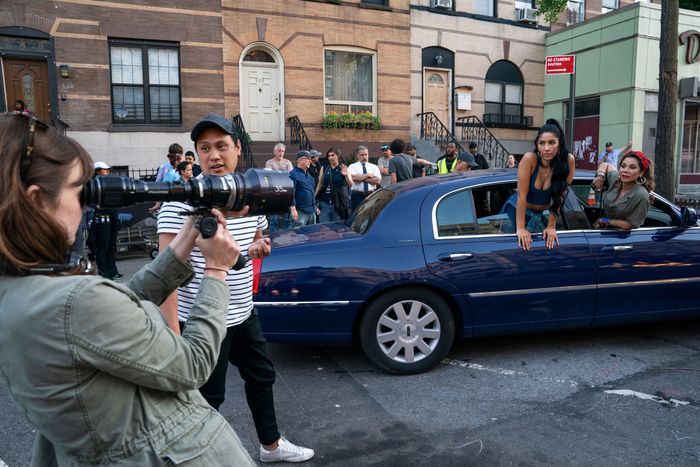
When Jon M. Chu asked his Crazy Rich Asians production designer, Nelson Coates, if he was interested in working on a film adaptation of In the Heights, Coates played it cool. “I had been chasing the project for years,” Coates says, “but I didn’t tell Jon that I knew he was attached.” Tasked with expanding the scope of a beloved stage musical while authentically depicting the Manhattan neighborhood it’s set in, Coates reunited with Crazy Rich Asians set decorator Andrew Baseman and dived headfirst into research.
As part of that process, the production designer spent two days sifting through files at the Main Branch of the New York Public Library, where he took particular interest in photos of Washington Heights from ten to 20 years ago. In its translation from stage to screen, In the Heights had become a memory piece, its action framed by a present-day Usnavi (Anthony Ramos) narrating the events of the musical to a group of children. Coates and Baseman’s work often reflects that framing, the sets and exteriors gelling together seamlessly to capture a fading moment in time in a rapidly changing neighborhood. As if the work itself didn’t offer enough obstacles, Coates also guided the production through the logistical challenges of shooting in New York City, negotiating with various stakeholders to secure locations such as Highbridge Pool and an MTA maintenance facility.
Ahead of the film’s release, Vulture caught up with Coates and Baseman to talk about the romance of movie musicals and the importance of developing a backstory for every set. (Warning: Some minor spoilers are ahead!)
You both previously worked with [director] Jon M. Chu on Crazy Rich Asians. How did that experience inform your approach to creating an onscreen Washington Heights?
Nelson Coates: They couldn’t be more different, in some ways, but a level of specificity, culturally, was very important on both projects. Jon loved the level of detail in what I was bringing to Crazy Rich Asians. He appreciated what I was doing research-wise with the Peranakan culture that’s not in the book — the fact that it was assigning looks to each of the characters. He wanted to have a very specific look as well to Washington Heights.
Andrew Baseman: What’s great about our work is that every script is different, so one day could be in the Gilded Age in the 1880s, another day could be futuristic. Working with Jon and Nelson on [Crazy Rich Asians], it didn’t prepare us for the actual story; it was just how you work together personally and professionally.
N.C.: Jon loves [that] I do huge walls of detail, so that you can see each number and each scene, and he’s able to look through and say, “Okay, yes, here’s the through-line visually for the show” and can show the actors. So I did that for In the Heights, creating a wall of just the graffiti I was finding. I walked every single street of Washington Heights and Inwood and the Bronx, and parts of Harlem, just looking at what made the Heights bodegas different than bodegas in other parts of town, or what makes salons different and specific for Washington Heights. And what cultural things people have brought in from Puerto Rico, the Dominican Republic, and Cuba that are still intact, and what things have blended over time. Just taking copious photographs of windows and the way people dress their homes, and these shops and things, and then curating and figuring out how to get that into the movie. That level of detail, and seeing how important it is for people to be represented appropriately and not stereotypically, was very important to Jon and myself.
The movie incorporates some specific design elements from the stage show — specifically some of the store façades and even the symmetry of the items on the shelves. How do you maintain some of those core elements from a beloved stage show while expanding the vision of it?
N.C.: Ironically, if you look actually at the stage sets, they look nothing like what the movie looks like. There’s a feeling, though, so the feeling is important. Since we had the opportunity to do this cinematically and add scale and scope, it was really about how we expand [without making] it suffocate, being claustrophobic like it would be on a 45-foot proscenium stage. Every aspect of this has to be shootable and choreograph-able as well, so in the choreographic development of this, I would be right beside Chris [Scott, the choreographer], and [he would say], “If he could jump up onto the counter, can we make it something that can do that?” We would tape out the size of each space and put in stand-in pieces of set dressing so that there would be something to rehearse to. Then we could say, “Oh, you know what, this volume needs to be a little larger,” or “This shelf needs to be a little lower” — literally [we’d go through] every moment like that. And then we’d give them a whole series of products so you could start playing with types of things. If you went down the shelves of the bodega, you would see things that are so specific to Washington Heights, even in how they’re labeled and how sticky the packaging is.
One of the central design elements of Usnavi’s bodega is the map [of the Dominican Republic] that’s on the wall, which to me scanned as a literalization of the themes of heritage and of him pursuing his dream of returning to the DR. How do you translate those overarching themes into a physical space?
N.C.: Part of that was in the discovery, as we found things. But one of the central things that Jon brought up was, “You know, Americans are geographically challenged.” And if there’s some way that we can help people know where the Dominican [Republic] is, it’s going to help solidify, Oh, here’s what’s going on. Jon wanted something in the bodega to be the constant dream, not only the pictures that Usnavi has on the wall of his bedroom but something that’s in the business.
A.B.: It’s very romantic, it’s very movie musical to have something like that, because I’ve never been to a bodega with a mural like that [laughs]. Jon wanted evidence of the flags — Dominican, Cuban, and Puerto Rican flags. He really wanted to show [the characters’] backgrounds. So this map was very much that: It’s the pride and ethnicity and the heart. [The movie] takes place in New York in the Heights, but it’s a map of where they came from and shows the pull that Usnavi has to go back home.
N.C.: And the map is made from pieces of everything he sells in the bodega. So if you look really closely, there’s MetroCards, Sweet’N Low packets, Pepperidge Farm fish. There’s keys, because they make keys — in fact, the Florida Keys on the map are actual keys. One of my crew members was actually going on his honeymoon [to the DR] the very first week of prep, so I asked him to bring a bag of sand back. I wanted to bless every element of the set with things that were very authentic to the culture, and also to Lin [-Manuel Miranda] and Quiara [Alegría Hudes], and the crew.
There are so many moving components to the salon set, from the styling chairs to the tables to the nodding mannequin heads. How does the choreography and the kinetic nature of a musical like In the Heights complicate your work?
A.B.: I don’t think it complicates the work; I think it gives it life and gives it focus. The bodega and the salon are the heart of the neighborhood. That’s where you get your gossip; that’s where you have a very intimate relationship with the people working there. It’s filled with characters, and for the musical number, we wanted a big enough space where they can dance. We needed all the elements to be on casters so they could move them somewhat organically. As the musical number is starting, you can see them moving the chairs out of the way and moving the tables. From the very beginning, it was designed for the movement and making room for the dancing.
N.C.: You want to make a great playground, so that everyone feels like it’s real, but also maybe it’s a little bit larger of a volume than you would actually find in the Heights. Most of the salons now are painted white, with LED lighting, and that’s not very cinematic, so I was pulling elements from what the Heights used to be without making it feel like a period movie.
The salon has a sort of sun-bleached aspect to it, at the same time as having vibrant colors, as if the walls were painted 20 years ago.
A.B.: Or even longer. There really aren’t a lot of primary colors — except for flag colors — throughout the movie. So the salon is in secondary and tertiary colors — you know, pinks and greens. The art of it is a little bit Art Deco, so Nelson and I were discussing that perhaps it was originally designed as a jewelry store or a clothing store, that it was taken on by the salon owners maybe 50 years ago. So that’s why it has that look. It wasn’t from the ground up designed as a salon. [Things like] the pattern of the linoleum, that would’ve been there since the ’40s. These are some of the details that — you know, we think of the backstory because we have to physically design this, go out and get these elements, and put them in there, and a lot of it is very subtle.
A few sequences in the movie are told from a specific character’s perspective or function on dream logic — specifically the sequence with Abuela Claudia in the subway. How did you approach that sequence, and does your understanding of the character’s perspective affect the design elements?
N.C.: Definitely. Several of the things she says are incredible touchpoints. Jon had the idea of, one, it’s the summer’s hottest day, as she says at the beginning of it. So we needed to really feel the heat. And two, she’s transporting us to her memory, to the past. Jon had initially wanted this to be in a black-box kind of environment, so that things could be shifting and changing, and I wanted there to be some shape to help us, some New York shape to the space, so it wasn’t a soundstage. As the subway is cutting right through the Heights, it was like, That is a great method of conveyance, to memory. The idea of her getting into the car — and the electrical [lighting] shuddering like it does when you go into tunnels — gave us the idea to change the background into Cuba 1944, and all the ads change to views of Cuba and the palm trees of Cuba, and the people change too.
So immediately you’re transported and then Chris and Jon worked out the specific elements, and I started then designing pieces that would go into that. You know [Claudia’s] dream of going to New York? Well, you have the sign in the subway that lights up. And you have the old signage from the period she would’ve been in. Because it’s a dream, how do you represent the city being super-packed? We always say, “You’re living out of a suitcase,” so let’s have dancers come out of suitcases, because that’s how they’re living. So immediately you know you’re packing, and she’s learning English, so you have a girl sitting around oversize books, flipping through the pages of the books trying to learn English. We found each of those elements and then started connecting them.
The framing device of the movie is this narration, where Usnavi is speaking to children on the beach. It sort of fades at the end until you realize that it’s actually been the bodega all along. I love the visual hints at that twist in the beach iteration of the bar. Can you talk a little bit about that and where that was shot?
A.B.: The beach scene was shot [in Glen Cove, New York], and we found a little sandy area and brought in that little beach hut. Ashley [Wellbrock] found the boat-shaped counter, so we had to find specific boats and things like that. The same source had bookcases in the shape of boats, so we filled it with that. Then through the visual effects, they put in the palm trees around it.
The concept of bookending, of starting this memory piece, or fantasy or whatever, with the kids on the beach and then you find out it’s really [at the bodega] the whole time — I don’t think that was in the original script. So when [that] developed, we specifically put in little hints and Easter eggs throughout, like the crab. I had pictures of Usnavi’s father, and those were under the glass in the counter. The lighting was made from cans — I believe coffee cans. And those were in the bodega. So all the things that were evidence in the fantasy portion of it were from the actual bodega. It was a play back and forth between reality and this fantasy we were creating.



